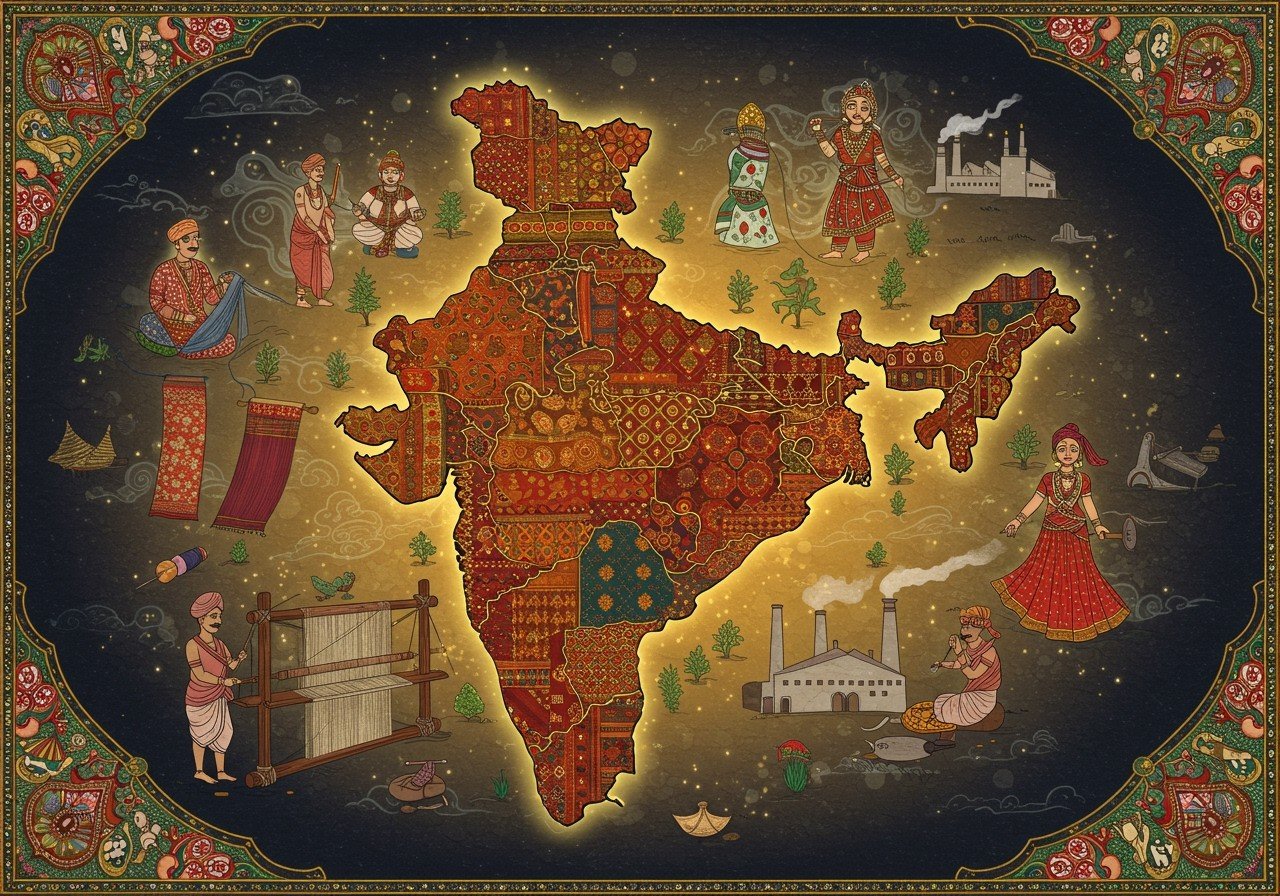
India’s textile industry is a captivating blend of ancient traditions and modern innovation, deeply interwoven with the nation’s cultural identity and economic strength. More than just fabric, textiles represent a legacy of craftsmanship and artistry passed down through generations. This exploration delves into the diverse tapestry of India’s textile geography, revealing how tradition and innovation intertwine in every thread.
A Journey Through India’s Textile Geography
The Indian textile industry, a cornerstone of the nation’s economy, supports over 45 million people and contributes significantly to its global presence. It accounts for approximately 2.3% of the country’s GDP, 13% of industrial production, and 12% of exports. The industry’s geographical distribution reflects a rich history, diverse resources, and specialized craftsmanship, resulting in a vibrant array of textiles.
Key Manufacturing Hubs
Gujarat: The Cotton Kingdom
Gujarat stands as a prominent cotton textile producer, renowned for denim and the delicate artistry of rayon sarees. Ahmedabad, often called the “Manchester of India,” along with Surat (known as the “Synthetic Capital of India”), Vadodara, and Bharauch, form the core of Gujarat’s textile prowess.
Maharashtra: A Textile Powerhouse
Maharashtra seamlessly blends traditional textile artistry with modern garment production. Mumbai serves as a major fashion hub, while cities like Sholapur, Kolhapur, and Nagpur contribute significantly to the state’s cotton textile industry.
Tamil Nadu: The Knitwear Capital
Tamil Nadu holds the title of “Knitwear Capital of India,” driven by the thriving textile industry in Tirupur. Karur, known as the “Textile Capital of Tamil Nadu,” specializes in home textiles. Other important centers include Chennai, Erode, Madurai, Salem, and Coimbatore (known as the “Manchester of South India”).
Textile Treasures Across the Nation
- Uttar Pradesh: Famous for its exquisite Banarasi silk sarees and intricate Chikankari embroidery. Kanpur also holds a prominent position in leather goods manufacturing.
- West Bengal: A historical center for silk and jute production, crafting elegant Baluchari sarees and luxurious Tussar silk garments. Kolkata serves as a major hub for these industries.
- Telangana: Home to Pochampally, known as the “Silk City of India,” renowned for its unique Ikat fabrics. The rich history and diverse techniques make Telangana’s textiles stand out.
- Madhya Pradesh: Celebrated for its delicate Chanderi sarees. Indore, Gwalior, and Ujjain are also significant textile centers within the state.
- Rajasthan: Known for its distinctive Kota Doria sarees, showcasing traditional weaving techniques. Jaipur, Sriganganagar, and Bhilwara also contribute to the state’s textile landscape.
- Karnataka: Bangalore, Belgaum, and Mysore are important cotton textile producing centers, while Ilkal stands out with its own unique textile heritage.
Key Products and Influencing Factors
- Cotton Textiles: Primarily produced in Gujarat, Maharashtra, and Tamil Nadu, cotton textiles are a staple of the Indian industry.
- Silk Textiles: West Bengal, Karnataka, and Tamil Nadu are known for their silk production, ranging from traditional sarees to luxurious garments.
- Jute Textiles: West Bengal is the leading producer of jute products, a sustainable and versatile fiber.
- Handloom Textiles: Varanasi, Godda, and Shiva Sagar stand out as major handloom clusters, preserving ancient weaving techniques and producing exquisite handcrafted textiles.
- Knitwear: Tirupur in Tamil Nadu, the “Knitwear Capital of India,” drives the nation’s knitwear industry.
- Home Textiles: Karur in Tamil Nadu plays a crucial role in the export and manufacture of home textiles.
The geographical distribution of the textile industry is influenced by various factors, including the availability of raw materials like cotton, jute, and silk, access to markets, transportation infrastructure, skilled labor, and suitable climate conditions. The Indian government actively supports the textile sector through initiatives focused on modernization, infrastructure development, and enhancing global competitiveness.
Poojn.in: Celebrating India’s Textile Heritage
Poojn.in, India’s leading online store for cultural goods and services, proudly offers a curated selection of authentic Indian textiles, connecting you directly with the rich traditions of the country’s textile industry. Explore our collection of high-quality products, including:
- Pure silk vastras from Varanasi Explore our collection of Puja vastras
- Cotton puja clothes from Gujarat
- Traditional dhoti and angavastram from Tamil Nadu
- Ceremonial shawls from Kashmir
- Handwoven gamcha from Bengal
Poojn.in provides:
- Direct shipping from textile manufacturing centers across India.
- Quality-checked authentic materials ideal for religious ceremonies and personal use.
- A diverse selection of traditional textiles in various sizes and styles to cater to individual preferences.
- Detailed product descriptions with comprehensive fabric specifications to help you make informed choices.
- A reliable pan-India delivery network ensuring access to our collection across all major textile regions.
Discover the perfect textiles for your puja and ritual needs at poojn.in. Visit our website or download our mobile app to explore our complete range of authentic Indian textiles for religious and ceremonial use. We deliver across India, bringing the richness of traditional textiles directly to your doorstep.
The Future of Indian Textiles
India’s textile geography is a vibrant tapestry woven from threads of history, culture, and a thriving modern industry. Each region contributes its unique artistry and craftsmanship, creating a colorful mosaic that represents India’s rich heritage. From the cotton fields of Gujarat to the powerlooms of Tamil Nadu, from the silk marvels of West Bengal to the intricate weaves of Rajasthan, every corner of India adds its own charm and expertise.
Supporting millions of livelihoods and significantly impacting the economy, the textile industry reflects a deep connection between tradition and innovation. Government initiatives and the unwavering dedication of skilled artisans ensure that India’s textiles continue to flourish on the global stage.
As India embraces modernity, the reverence for traditional practices remains strong. This balance ensures that Indian textiles remain a source of national pride and cultural identity. The vibrant tapestry of India’s textile geography is more than just cloth; it is a powerful symbol of the nation’s cultural richness and its promising future.
Andhra Pradesh: A Journey Through Time, History, and Formation
Andhra Pradesh State Symbols: Exploring Regional Identity


